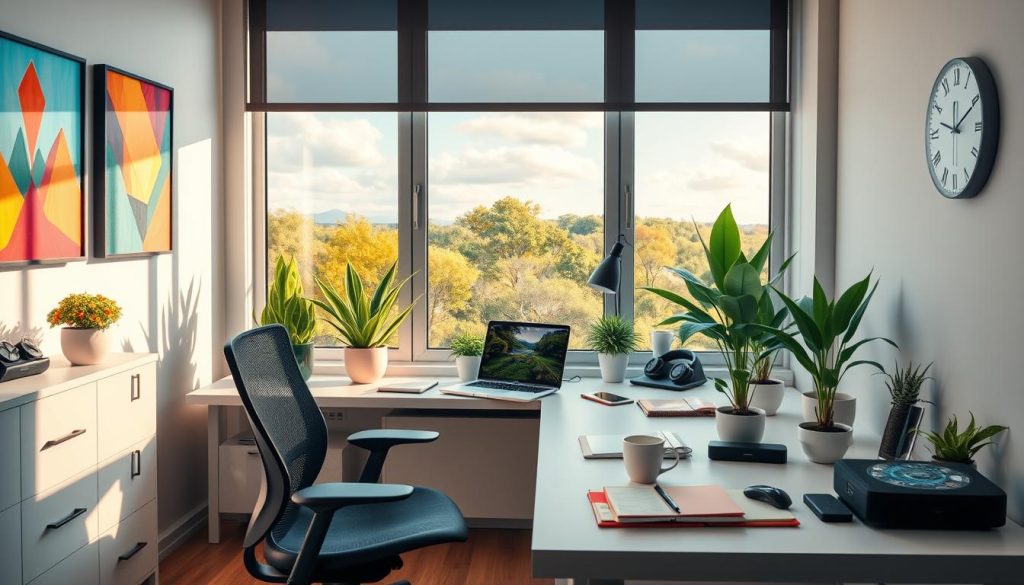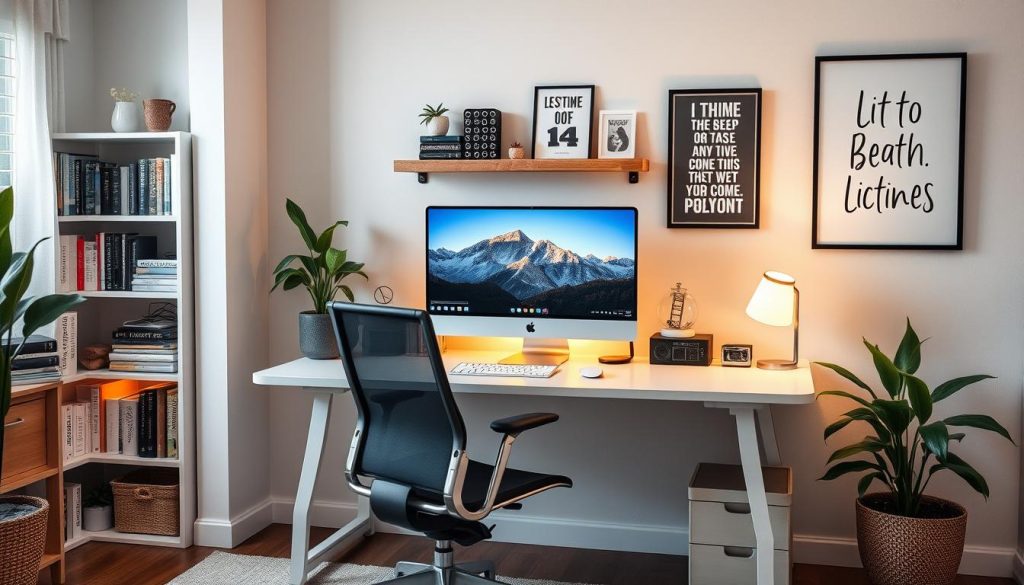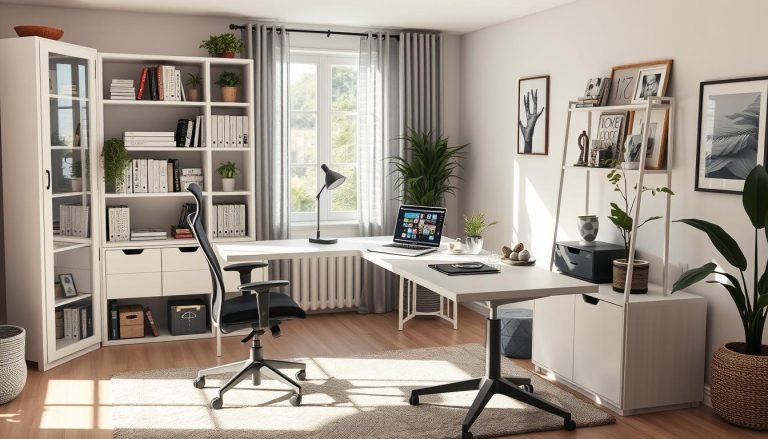Essential Tips for Nailing Remote Work Success
Remote work is becoming more common today. I’ve found key strategies for doing well while working from home. With 98% of remote workers wanting to keep working from home, it’s important to know the basics.
Using the right tools and setting up a good workspace are crucial. These items help you work better and feel happier at your job. For example, gadgets for remote work can help you stay focused. A comfortable workspace gets you ready for success.
I want to share tips on handling remote work’s ups and downs. We’ll talk about setting a routine and using technology. These are important for a successful work-from-home life.
Understanding the Rise of Remote Work
The COVID-19 pandemic made remote work more common. Now, 35% of U.S. workers work from home full-time. Another 41% work a mix of home and office. This change shows how valuable flexible work schedules are today.
Remote job listings have grown from 12% to 20% in two years. This shows more people want jobs that can be done from anywhere. Companies are looking at how to make jobs work well from home, like IT and marketing roles.
Employers need to improve their tech and communication. Tools like video calls, cloud services, and secure data are key. This helps everyone work together better, even when they’re apart.
More people are using platforms like Microsoft Teams. It went from 20 million to 145 million users in just two years. This shows how important tech is for remote work. By 2025, over 85% of businesses will use the cloud first.
About 65% of workers want to keep working from home after the pandemic. They say it helps them balance work and life better. Working from home also means less stress and less harm to the environment.

But, remote work has its challenges. It can make communication harder and make people feel left out. Companies need to find ways to keep everyone connected and valued, even when they’re not in the same place.
The Benefits of Working from Home
Working from home has many perks that make life better. I love the flexibility it offers. No more long commutes, which saves time and reduces stress. In fact, remote workers save about $4,000 a year, which they can use for other things.
Being able to set up your own workspace is a big plus. Studies show that 77% of people think a custom space makes them more productive. It also helps with work-life balance. I can plan my family time better while still doing my job well.

Remote work makes people happier and less stressed. 82% of remote workers feel less anxious. This shows a big improvement in mental health. Plus, flexible hours help manage time better, keeping personal and work life in balance.
Employers also win big with remote work. They can find better talent and save money, about 40% on costs. Remote workers are more motivated, with 83% feeling more engaged. This means everyone benefits from working from home.
Creating a Productive Workspace
Setting up a productive workspace is key for remote work. A good space boosts focus, comfort, and efficiency. Here are important things to think about for your workspace.
Choosing the Right Location
Look for a quiet, well-lit spot in your home. My top choice is a place free from distractions. It helps me focus better.
Having lots of natural light also improves my mood. This creates a space that encourages creativity and focus.
Setting Up Ergonomic Furniture
Comfort is crucial for staying productive. Ergonomic furniture, like adjustable desks and supportive chairs, makes a big difference. It prevents physical strain during long work hours.
This investment keeps my body aligned. It lets me work for longer without feeling uncomfortable.
Minimizing Distractions
To reduce distractions, organize your space well. Declutter and set areas for different tasks. Limiting family and pet interruptions helps too.
These steps make your remote work space efficient. They help you work better and stay focused.

Remote Work Essentials: Must-Have Tools
Finding the right remote work tools is key for staying productive and connected. With new tech, there are many ways to make working from home better. Here are my top picks for tools that keep me organized and effective.
Communication Platforms
It’s important to stay in touch with my team, even when we’re apart. Slack and Microsoft Teams are must-haves for easy communication. They offer messaging, file sharing, and video calls, making them vital productivity applications.
Project Management Software
I use Trello and Asana to manage tasks and work with others. They help me organize tasks, assign them, and track progress. These tools keep my projects on track, making them essential remote work tools.
Time Tracking Tools
Time tracking tools are important for accountability and self-management. Toggl lets me see how much time I spend on tasks, helping me stay focused. These tools help me understand my work habits and make improvements, making them must-haves.

Developing a Consistent Work Routine
Creating a consistent work routine is key to boosting productivity when working from home. A structured plan helps me manage my day better and cut down on distractions. This can increase productivity by up to 65%.
Starting this journey involves setting fixed working hours. It’s the first step towards becoming more efficient.
Setting Fixed Working Hours
Setting fixed working hours helps me separate work from personal life. It prevents burnout and keeps me focused. Studies show that 92% of productive people start their day with a routine.
Having these hours also brings a sense of normalcy to remote work. It helps me stay on track.
Time-Blocking Strategies
Time-blocking is another great way to improve my work routine. It involves dividing the day into focused work periods. This reduces the negative effects of multitasking.
Research shows multitasking can lower productivity by 40%. By dedicating time to specific tasks, I avoid distractions. This boosts productivity by up to 30%.

Maintaining a Work-Life Balance
Working from home brings great flexibility but can mix up work and personal life. I focus on keeping these areas separate. I set clear boundaries and plan breaks to help.
Establishing Clear Boundaries
Having a set work schedule is key, just like in an office. This helps me manage my work and personal life better. I use time-tracking software to stay on track and productive.
Setting these boundaries helps me avoid distractions. This means less family interruptions and more focus on my work.
Planning Time for Breaks
Planning breaks is vital for my energy and creativity. Regular breaks boost my productivity and prevent burnout. I remind myself to take breaks, like going for a walk.
These breaks refresh my mind and help me come back to work with more energy. This way, I take care of myself and meet my work goals.

Mastering Remote Communication Skills
Learning to communicate well when working remotely is crucial. Tools like video conferencing help us talk face-to-face even when we’re apart. Using these tools well keeps teams connected and working together effectively.
Utilizing Video Conferencing Tools
Platforms like Zoom and Google Meet are key for virtual meetings. Using them well can really improve how teams work together. Here are some tips to get the most out of video calls:
- Set clear agendas before meetings to ensure focused discussions.
- Utilize features like screen sharing to enhance understanding of complex topics.
- Record meetings when necessary, allowing team members to revisit discussions, reducing miscommunication.
- Be mindful of background distractions to maintain a professional atmosphere.
Effective Email Practices
Email is still a key way to communicate online. Good email habits can make our interactions smoother:
- Use clear subject lines to ensure recipients understand the content at a glance.
- Keep messages concise while clearly articulating key points to avoid misunderstandings.
- Establish consistent email protocols to set expectations on response times and formats.
- Provide context when discussing ongoing projects, which can help new team members understand background information.
By following these tips, we can improve our remote communication skills. This helps our teams work better together, even when we’re not in the same place. Good communication tools help us build a strong team culture, no matter where we are.
Building and Maintaining Team Connections
In today’s remote work world, strong team connections are key to success. Moving to virtual settings has made it harder to build good working relationships. To overcome this, I use different strategies to help teams bond and work together well.
Virtual Team Building Activities
Virtual team building activities can really improve team dynamics. These activities help teams connect, build trust, and rapport. Some great activities include:
- Online Games: Game nights can make everyone laugh and foster friendly competition.
- Collaborative Projects: Working on creative tasks together can spark new ideas and strengthen bonds.
- Virtual Coffee Breaks: Casual chats over coffee help colleagues get to know each other better.
Using these techniques can help fight off feelings of loneliness and make everyone feel part of the team. Since the pandemic started, 62% of employees have found it hard to connect with others. So, these activities are more important than ever.
Best Practices for Remote Collaboration
Good remote teamwork relies on clear communication and understanding. I believe in keeping things organized. Here are some key practices:
- Utilizing Technology: Tools like Zoom and Slack make talking and working together easy.
- Establishing Clear Roles: Knowing who does what helps avoid confusion and boosts teamwork.
- Regular Feedback: Regular check-ins and helpful feedback help everyone grow and support each other.
Building trust is essential for remote teams. Task-based trust comes from being reliable, while relationship-based trust grows over time. Focusing on emotional intelligence in the team creates a caring space where everyone feels important. Working hard to strengthen these bonds can make teams more productive and happy.
Setting Daily and Weekly Goals
Setting clear goals is key for staying focused and efficient while working from home. An action plan makes tasks simpler and helps me stay on track. It keeps me organized and motivated to reach my goals.
Creating an Action Plan
An effective action plan breaks down big goals into smaller steps. Using goal setting strategies helps me pick specific tasks for my goals. Here’s how I make my plan:
- Define clear and specific goals: This helps me know what I’m aiming for.
- Prioritize tasks: I tackle the most important tasks first.
- Set realistic deadlines: Timelines that are achievable keep me on track.
- Review and adjust regularly: Tracking progress lets me adjust my plan as needed.
Using Goal Tracking Apps
Goal tracking apps help me keep an eye on my progress. They show me my achievements, which motivates me. Tools like Asana or Trello help me stay focused on my goals. They let me see where I am on tasks and make changes if needed. Here are some benefits of using these apps:
- Visual representation: Dashboards show me my progress and tasks to do.
- Real-time updates: Notifications keep everyone informed about deadlines.
- Continuous feedback: Regular reviews in the app help us adjust strategies.
Leveraging Technology for Productivity
In the world of remote work, the right technology can really boost productivity. I’ve found that using various tools simplifies tasks and improves the remote work experience. I focus on automation tools and essential gadgets for telecommuting.
Automation Tools to Simplify Tasks
Automation for remote work has changed the game for many. Tools like Zapier, IFTTT, and Microsoft Power Automate help automate repetitive tasks. This lets me focus on more important tasks.
- Data entry and transfer between applications.
- Setting reminders for project deadlines.
- Managing email notifications and responses.
These productivity technology solutions create workflows that work behind the scenes. This frees me to think creatively and solve problems.
Using Telecommuting Gadgets
The right gadgets make remote work better. I use noise-canceling headphones to block distractions and focus. Good webcams are key for professional virtual meetings.
- Ergonomic keyboards that reduce strain during long hours of work.
- Adjustable stands for laptops to improve posture.
- Portable chargers that keep devices ready for any location.
Using these technologies helps me create a comfortable and productive space. Remote work becomes effective and enjoyable.
Adopting a Professional Mindset
Having a professional mindset is key to success in remote work. The right attitude can boost my productivity and work experience. I use certain strategies to stay focused and motivated all day.
Getting Dressed for Success
Wearing the right clothes is important for my professional attitude. Wearing work clothes helps me get into a productive mindset. While loungewear is comfy, dressing up keeps me focused and engaged.
Even online, dressing professionally boosts my performance and confidence. It makes a big difference in how I work and feel.
Positive Self-Talk Techniques
Using positive self-talk helps me stay motivated. I remind myself of my goals and what I’ve achieved. This boosts my productivity and keeps me committed to being professional.
By believing in myself, I stay positive and handle remote work challenges well. Positive self-talk is crucial for success in remote work.
Overcoming Common Remote Work Challenges
Every remote worker faces their own challenges. I’ve had my share too. Managing distractions at home is a big one. Creating a dedicated workspace helps me stay on track.
Setting clear boundaries with family or roommates is key. This way, I can focus without interruptions. It boosts my productivity and keeps me from getting sidetracked.
Managing Distractions at Home
Having a specific workspace is important, but it’s not everything. I use tools to block online distractions and set work hours. This helps me stay focused and manage my time better.
Without direct supervision, time management can be tough. But, by structuring my day, I can tackle my tasks efficiently. This keeps me from getting lost in distractions.
Dealing with Isolation
Feeling lonely while working remotely is common. It’s harder to have casual chats like in an office. To fight this, I make sure to check in with my team regularly.
I also join virtual team-building activities. These help me feel connected to my team. It reminds me I’m part of a bigger group. Keeping these connections strong is crucial for teamwork and engagement in our flexible work world.




